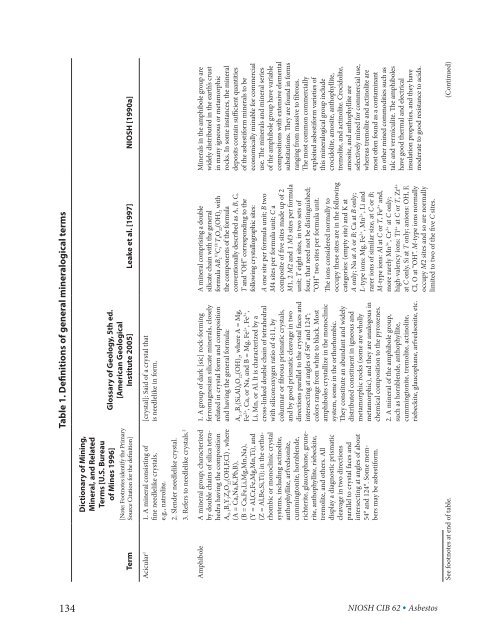Asbestos Fibers and Other Elongate Mineral Particles: State of the ...
Asbestos Fibers and Other Elongate Mineral Particles: State of the ...
Asbestos Fibers and Other Elongate Mineral Particles: State of the ...
- No tags were found...
You also want an ePaper? Increase the reach of your titles
YUMPU automatically turns print PDFs into web optimized ePapers that Google loves.
Table 1. Definitions <strong>of</strong> general mineralogical terms<br />
134<br />
Glossary <strong>of</strong> Geology, 5th ed.<br />
[American Geological<br />
Institute 2005] Leake et al. [1997] NIOSH [1990a]<br />
Dictionary <strong>of</strong> Mining,<br />
<strong>Mineral</strong>, <strong>and</strong> Related<br />
Terms [U.S. Bureau<br />
<strong>of</strong> Mines 1996]<br />
[Note: Footnotes identify <strong>the</strong> Primary<br />
Source Citation for <strong>the</strong> definition]<br />
Term<br />
[crystal]: Said <strong>of</strong> a crystal that<br />
is needlelike in form.<br />
Acicular1 1. A mineral consisting <strong>of</strong><br />
fine needlelike crystals,<br />
e.g., natrolite.<br />
2. Slender needlelike crystal.<br />
3. Refers to needlelike crystals. 2<br />
<strong>Mineral</strong>s in <strong>the</strong> amphibole group are<br />
widely distributed in <strong>the</strong> earth’s crust<br />
in many igneous or metamorphic<br />
rocks. In some instances, <strong>the</strong> mineral<br />
deposits contain sufficient quantities<br />
<strong>of</strong> <strong>the</strong> asbestiform minerals to be<br />
economically minable for commercial<br />
use. The minerals <strong>and</strong> mineral series<br />
<strong>of</strong> <strong>the</strong> amphibole group have variable<br />
compositions with extensive elemental<br />
substitutions. They are found in forms<br />
ranging from massive to fibrous.<br />
The most common commercially<br />
exploited asbestiform varieties <strong>of</strong><br />
this mineralogical group include<br />
crocidolite, amosite, anthophyllite,<br />
tremolite, <strong>and</strong> actinolite. Crocidolite,<br />
amosite, <strong>and</strong> anthophyllite are<br />
selectively mined for commercial use,<br />
whereas tremolite <strong>and</strong> actinolite are<br />
most <strong>of</strong>ten found as a contaminant<br />
in o<strong>the</strong>r mined commodities such as<br />
talc <strong>and</strong> vermiculite. The amphiboles<br />
have good <strong>the</strong>rmal <strong>and</strong> electrical<br />
insulation properties, <strong>and</strong> <strong>the</strong>y have<br />
moderate to good resistance to acids.<br />
A mineral comprising a double<br />
silicate chain with <strong>the</strong> general<br />
VI IV formula AB2 C5 T8O22(OH) 2 with<br />
<strong>the</strong> components <strong>of</strong> <strong>the</strong> formula<br />
conventionally described as A, B, C,<br />
T <strong>and</strong> “OH” corresponding to <strong>the</strong><br />
following crystallographic sites:<br />
A one site per formula unit; B two<br />
M4 sites per formula unit; C a<br />
composite <strong>of</strong> five sites made up <strong>of</strong> 2<br />
M1, 2 M2 <strong>and</strong> 1 M3 sites per formula<br />
unit; T eight sites, in two sets <strong>of</strong><br />
four, that need not be distinguished;<br />
“OH” two sites per formula unit.<br />
The ions considered normally to<br />
occupy <strong>the</strong>se sites are in <strong>the</strong> following<br />
categories: (empty site) <strong>and</strong> K at<br />
A only; Na at A or B; Ca at B only;<br />
L-type ions: Mg, Fe2+ , Mn2+ , Li <strong>and</strong><br />
rarer ions <strong>of</strong> similar size, at C or B;<br />
M-type ions: Al at C or T, Fe3+ <strong>and</strong>,<br />
more rarely Mn3+ , Cr3+ at C only;<br />
high-valency ions: Ti4+ at C or T, Zr4+ at C only, Si at T only; anions: OH, F,<br />
Cl, O at “OH”. M-type ions normally<br />
occupy M2 sites <strong>and</strong> so are normally<br />
limited to two <strong>of</strong> <strong>the</strong> five C sites.<br />
1. A group <strong>of</strong> dark [sic] rock-forming<br />
ferromagnesian silicate minerals, closely<br />
related in crystal form <strong>and</strong> composition<br />
<strong>and</strong> having <strong>the</strong> general formula:<br />
A2-3B5(Si,Al) 8O22(OH) 2, where A = Mg,<br />
Fe2+ , Ca, or Na, <strong>and</strong> B = Mg, Fe2+ , Fe3+ ,<br />
Li, Mn, or Al. It is characterized by a<br />
cross-linked double chain <strong>of</strong> tetrahedral<br />
with silicon:oxygen ratio <strong>of</strong> 4:11, by<br />
columnar or fibrous prismatic crystals,<br />
<strong>and</strong> by good prismatic cleavage in two<br />
directions parallel to <strong>the</strong> crystal faces <strong>and</strong><br />
intersecting at angles <strong>of</strong> 56° <strong>and</strong> 124°;<br />
colors range from white to black. Most<br />
amphiboles crystallize in <strong>the</strong> monoclinic<br />
system, some in <strong>the</strong> orthorhombic.<br />
They constitute an abundant <strong>and</strong> widely<br />
distributed constituent in igneous <strong>and</strong><br />
metamorphic rocks (some are wholly<br />
metamorphic), <strong>and</strong> <strong>the</strong>y are analogous in<br />
chemical composition to <strong>the</strong> pyroxenes.<br />
2. A mineral <strong>of</strong> <strong>the</strong> amphibole group,<br />
such as hornblende, anthophyllite,<br />
cummingtonite, tremolite, actinolite,<br />
riebeckite, glaucophane, arfvedsonite, etc.<br />
Amphibole A mineral group; characterized<br />
by double chains <strong>of</strong> silica tetrahedra<br />
having <strong>the</strong> composition<br />
A0-1B2Y5Z8O22(OH,F,Cl) , where<br />
(A = Ca,Na,K,Pb,B),<br />
(B = Ca,Fe,Li,Mg,Mn,Na),<br />
(Y = Al,Cr,Fe,Mg,Mn,Ti), <strong>and</strong><br />
(Z = Al,Be,Si,Ti); in <strong>the</strong> orthorhombic<br />
or monoclinic crystal<br />
systems, including actinolite,<br />
anthophyllite, arfvedsonite,<br />
cummingtonite, hornblende,<br />
richterite, glaucophane, grunerite,<br />
anthophyllite, riebeckite,<br />
tremolite, <strong>and</strong> o<strong>the</strong>rs. All<br />
display a diagnostic prismatic<br />
cleavage in two directions<br />
parallel to crystal faces <strong>and</strong><br />
intersecting at angles <strong>of</strong> about<br />
54° <strong>and</strong> 124°. Some members<br />
may be asbestiform.<br />
NIOSH CIB 62 • <strong>Asbestos</strong><br />
See footnotes at end <strong>of</strong> table. (Continued)

















